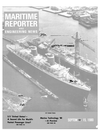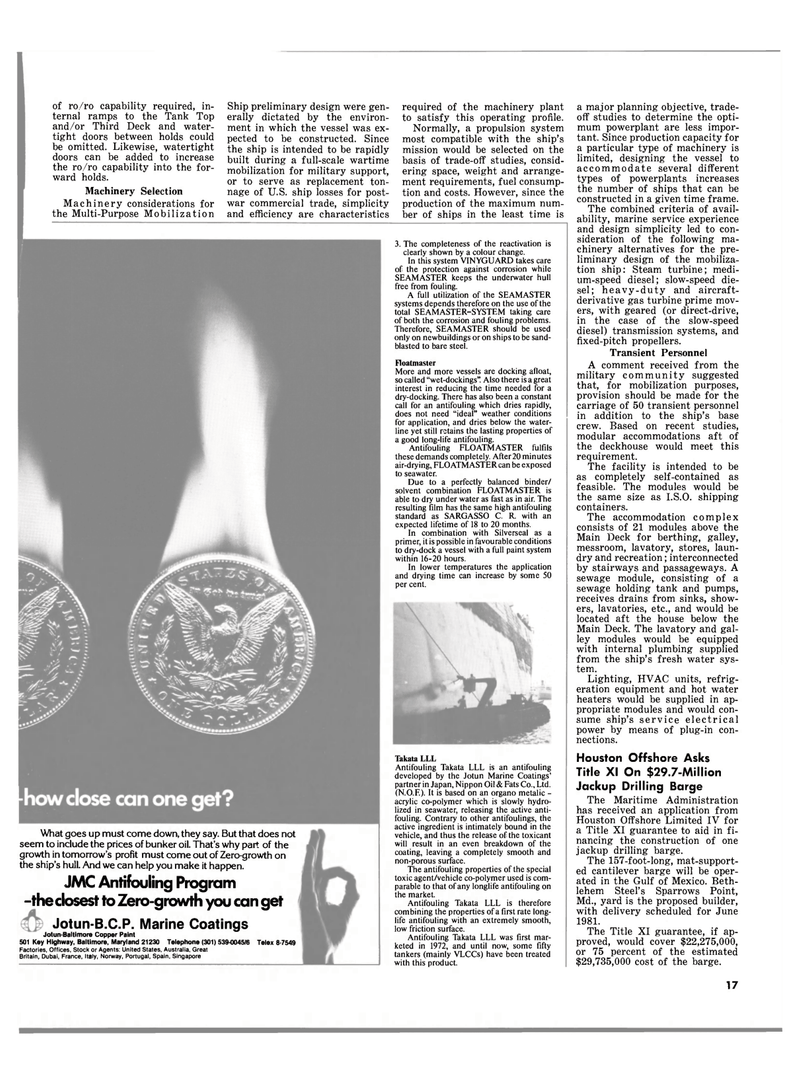
Page 15: of Maritime Reporter Magazine (September 15, 1980)
Read this page in Pdf, Flash or Html5 edition of September 15, 1980 Maritime Reporter Magazine
of ro/ro capability required, in- ternal ramps to the Tank Top and/or Third Deck and water- tight doors between holds could be omitted. Likewise, watertight doors can be added to increase the ro/ro capability into the for- ward holds.
Machinery Selection
Machinery considerations for the Multi-Purpose Mobilization
Ship preliminary design were gen- erally dictated by the environ- ment in which the vessel was ex- pected to be constructed. Since the ship is intended to be rapidly built during a full-scale wartime mobilization for military support, or to serve as replacement ton- nage of U.S. ship losses for post- war commercial trade, simplicity and efficiency are characteristics required of the machinery plant to satisfy this operating profile.
Normally, a propulsion system most compatible with the ship's mission would be selected on the basis of trade-off studies, consid- ering space, weight and arrange- ment requirements, fuel consump- tion and costs. However, since the production of the maximum num- ber of ships in the least time is
What goes up must come down, they say. But that does not seem to include the prices of bunker oil. That's why part of the growth in tomorrow's profit must come out of Zero-growth on the ship's hull. And we can help you make it happen.
JMC Antifouling Program -the closest to Zero-growth you can get
Jotun-B.C.P. Marine Coatings
Jotun-Baltimore Copper Paint 501 Key Highway, Baltimore, Maryland 21230 Telephone (301) 539-0045/6 Telex 8-7549
Factories, Offices, Stock or Agents: United States, Australia, Great
Britain, Dubai, France, Italy, Norway, Portugal, Spain, Singapore 3. The completeness of the reactivation is clearly shown by a colour change.
In this system VINYGUARD takes care of the protection against corrosion while
SEAMASTER keeps the underwater hull free from fouling.
A full utilization of the SEAMASTER systems depends therefore on the use of the total SEAMASTER-SYSTEM taking care of both the corrosion and fouling problems.
Therefore, SEAMASTER should be used only on newbuildings or on ships to be sand- blasted to bare steel.
Floatmaster
More and more vessels are docking afloat, so called "wet-dockings". Also there is a great interest in reducing the time needed for a dry-docking. There has also been a constant call for an antifouling which dries rapidly, does not need "ideal" weather conditions for application, and dries below the water- line yet still retains the lasting properties of a good long-life antifouling.
Antifouling FLOATMASTER fulfils these demands completely. After 20 minutes air-drying, FLOATMASTER can be exposed to seawater.
Due to a perfectly balanced binder/ solvent combination FLOATMASTER is able to dry under water as fast as in air. The resulting film has the same high antifouling standard as SARGASSO C. R with an expected lifetime of 18 to 20 months.
In combination with Silverseal as a primer, it is possible in favourable conditions to dry-dock a vessel with a full paint system within 16-20 hours.
In lower temperatures the application and drying time can increase by some 50 per cent.
Takata LLL
Antifouling Takata LLL is an antifouling developed by the Jotun Marine Coatings' partner in Japan, Nippon Oil & Fats Co., Ltd. (N.O.F.). It is based on an organo metalic - acrylic co-polymer which is slowly hydro- lized in seawater, releasing the active anti- fouling. Contrary to other antifoulings, the active ingredient is intimately bound in the vehicle, and thus the release of the toxicant will result in an even breakdown of the coating, leaving a completely smooth and non-porous surface.
The antifouling properties of the special toxic agent/vehicle co-polymer used is com- parable to that of any longlife antifouling on the market.
Antifouling Takata LLL is therefore combining the properties of a first rate long- life antifouling with an extremely smooth, low friction surface.
Antifouling Takata LLL was first mar- keted in 1972, and until now, some fifty tankers (mainly VLCCs) have been treated with this product. a major planning objective, trade- off studies to determine the opti- mum powerplant are less impor- tant. Since production capacity for a particular type of machinery is limited, designing the vessel to accommodate several different types of powerplants increases the number of ships that can be constructed in a given time frame.
The combined criteria of avail- ability, marine service experience and design simplicity led to con- sideration of the following ma- chinery alternatives for the pre- liminary design of the mobiliza- tion ship: Steam turbine; medi- um-speed diesel; slow-speed die- sel; heavy-duty and aircraft- derivative gas turbine prime mov- ers, with geared (or direct-drive, in the case of the slow-speed diesel) transmission systems, and fixed-pitch propellers.
Transient Personnel
A comment received from the military community suggested that, for mobilization purposes, provision should be made for the carriage of 50 transient personnel in addition to the ship's base crew. Based on recent studies, modular accommodations aft of the deckhouse would meet this requirement.
The facility is intended to be as completely self-contained as feasible. The modules would be the same size as I.S.O. shipping containers.
The accommodation complex consists of 21 modules above the
Main Deck for berthing, galley, messroom, lavatory, stores, laun- dry and recreation; interconnected by stairways and passageways. A sewage module, consisting of a sewage holding tank and pumps, receives drains from sinks, show- ers, lavatories, etc., and would be located aft the house below the
Main Deck. The lavatory and gal- ley modules would be equipped with internal plumbing supplied from the ship's fresh water sys- tem.
Lighting, HVAC units, refrig- eration equipment and hot water heaters would be supplied in ap- propriate modules and would con- sume ship's service electrical power by means of plug-in con- nections.
Houston Offshore Asks
Title XI On $29.7-Million
Jackup Drilling Barge
The Maritime Administration has received an application from
Houston Offshore Limited IV for a Title XI guarantee to aid in fi- nancing the construction of one jackup drilling barge.
The 157-foot-long, mat-support- ed cantilever barge will be oper- ated in the Gulf of Mexico. Beth- lehem Steel's Sparrows Point,
Md., yard is the proposed builder, with delivery scheduled for June 1981.
The Title XI guarantee, if ap- proved, would cover $22,275,000, or 75 percent of the estimated $29,735,000 cost of the barge. 17

 14
14

 16
16
